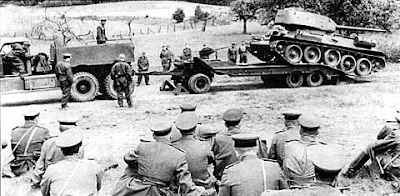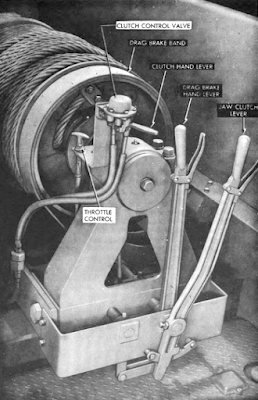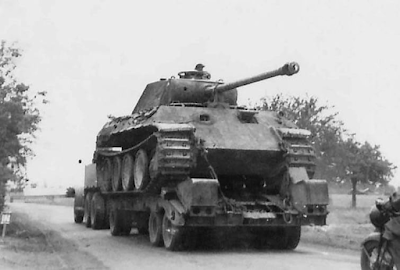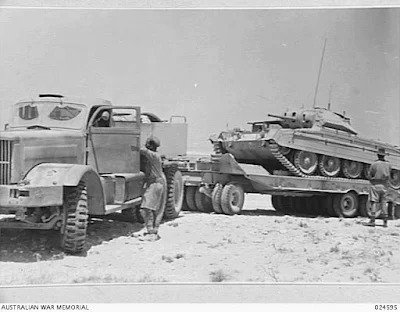 |
| Diamond T tank transporter of the British Army carrying a Grant tank in North Africa, 1942. |
The M19 Tank Transporter (US supply catalog designation G159) was a heavy tank transporter system used in World War II and into the 1950s. It consisted of a 12-ton 6×4 M20 Diamond T Model 980 truck and companion 12-wheel M9 trailer.
Over 5,000 were produced, and employed by Allied armies throughout all theaters of war. It was superseded in the U.S. military by the M25 Tank Transporter during the war, but usefully redeployed in other tasks. It was superseded by the Thornycroft Antar in British service by the early 1950s, though a few remained operational in units through 1971.
History
Designed as a heavy prime mover for tank transporting, the hard-cab Diamond T 980 was the product of the Diamond T Company in Chicago. In 1940 the British Purchasing Commission, looking to equip the British Army with a vehicle capable of transporting larger and heavier tanks, approached a number of American truck manufacturers to assess their models. The Diamond T Company had a long history of building rugged, military vehicles for the U.S. Army Quartermaster Corps and had recently produced a prototype heavy vehicle for the US Army which, with a few slight modifications met British requirements and an initial order for 200 was very quickly filled.
The result was the Diamond T 980, a 12-short-ton (11 t) hard-cab 6×4 truck. Powered by a Hercules DFXE diesel engine developing 201 hp (150 kW) and geared very low, it could pull a trailer of up to 115,000 lb (52 t) and proved capable of the task of moving the heaviest tanks then in service.
Specifications (M20 truck)
Engine
The M20 used a Hercules DFXE, a 855 cu in (14.011 L) displacement naturally aspirated inline 6-cylinder diesel engine developing 201 bhp (150 kW) at 1,600 rpm and 685 ft⋅lbf (929 N⋅m) at 1150 rpm. Designed for a British requirement, this was one of the few diesel engines used in US tactical trucks.
Driveline
A two plate dry disk diaphragm spring clutch drove Fuller four-speed main and three-speed auxiliary transmissions. The main transmission had a "low" first gear and three road gears, 4th being direct. The auxiliary had low, direct, and overdrive gears. The low gear allowed several very low gears for extreme off-road use. The direct and overdrive allowed the three road gears to be split, making six road gears.
Spicer driveshafts drove two Timken double-reduction axles with an 11.66:1 final drive ratio.
Chassis
The M20 truck had a riveted ladder frame with three beam axles, the front on leaf springs, the rear tandem on leaf springs with locating arms. The wheelbase was 179 in (455 cm), measured from the centerline of the front axle to the centerline of rear bogie. A pintle hitch of 115,000 lb (52,000 kg) capacity was mounted on the rear frame crossmember; another pintle hitch was mounted on the front crossmember for positioning the trailer.
All models had Budd split rim disc wheels with 12.20×20-20" tires. Dual rear mud and snow tires were used.
Air powered drum brakes were used on all axles; the trailer brakes could be operated independently of the service brakes. A single disk transmission brake parking brake was also provided. This used four brake pads with a cable clasp mechanism onto a 16 in (41 cm) disk, mounted behind the auxiliary transmission.
A Garwood winch of 40,000 lb (18,000 kg) capacity, with 300 ft (91 m) of cable, was mounted behind the cab. In the Model 980 it was intended mainly for hauling damaged tanks aboard the trailers. The Model 981, introduced in 1942, had a winch with 500 ft (150 m) of cable, which could be used from both the front and rear. This allowed tank recovery, in addition to loading.
Body
Early trucks used a standard Diamond T commercial cab, also used by the four-ton G509 trucks. In August 1943 it was replaced with an open military cab. A long butterfly hood had vertical louvres along both sides.
A short ballast body was mounted behind the winch. There were closed tool compartments along both sides, two open containers in the front, and a bottom-hinged tailgate. The spare tire was mounted in the front. The box could hold 18,000 lb (8,200 kg) of ballast to increase traction on the rear tandem axles.
Specifications (M9 trailer)
The M9 had tandem rear axles and a single front axle on a rotating dolly. Ramps hinged down at the rear end of the trailer. Cable rollers and sheaves let the winch from the M20 truck pull tanks onto the trailer, chocks and chains were used to secure the load.
The front axle suspension system was trailing beam assemblies on coil springs, with a dual tire wheel on each side of the beam. With an assembly on each side there were four wheels on the axle line.
The rear tandem beam assembly was a center pivot type, with axles on both ends of the beam. A dual tire wheel was on both ends of both axles, with a beam on each side there were also four wheels per axle line. Twenty-four 8.25×15" tires on demountable rims were used, two on each wheel.
Service
Production began in 1941. The first batch was received in Britain in 1942 and very quickly demonstrated their rugged reliability in the British campaign in North Africa. Battle-damaged tanks needed to be quickly recovered, often under hostile fire, and returned to workshops for repair.
5,871 were eventually built by 1945 and were used by virtually every Allied army in every theatre of World War II. U.S. forces in Europe preferred the M25 Tank Transporter, citing the fact that the M19 suffered from a wide turning radius, poor traction of the truck, and excessive rolling resistance. Five 1 short ton (910 kg) concrete blocks were routinely carried in the bed of the truck to improve traction; the conversion of an M20 truck and M9 trailer to a semi-trailer configuration rather than a trailed configuration alleviated some of these problems, and also improved fuel economy by approximately fifty percent. In general, the M19 was mechanically reliable, but "did not meet the overall requirements of this theater" and was relegated to duty in the rear areas of the combat zone and in the Communications Zone, with the M25 being used for frontline service.
The British Army took delivery of around 1,000 during the war years and many continued in service afterwards, being replaced in the early 1950s with the Thornycroft Antar ("Mighty Antar"), although a few remained in tank transporter units up to 1971. Many of those sold off by the Army after the war were snapped up by heavy haulage and recovery specialists, notably Pickfords and Wynns, and were a familiar sight on Britain's roads, pulling heavy lowloaders and fairground trailers or parked on garage forecourts, in readiness for a heavy rescue operation equipped as wreckers (breakdown recovery trucks). They suffered from "very limited off-road performance" as a result of only the two rear axles being driven.
Many of the 70-year-old Diamond Ts can still be found in private ownership in Britain and frequently appear at historic vehicle shows.
Nomenclature
This combination unit is referred to as the M19 tank transporter, consisting of the M20 tractor and M9 24-wheel trailer. In the nomenclature system used by the United States Army Ordnance Corps Supply Catalog this vehicle is referred as the G159. It was superseded by the M26. After the introduction of the M26, the U.S. relegated M20s to ammunition hauling, for which they proved "tremendous".
British designation for the tractor unit was Diamond T Tractor 6×4 for 40 ton Trailer with "Model 980" or "Model 981" added to distinguish the two. The British-built trailers were known as "40 ton Trailer British Mk. I (Crane)" "40 ton Trailer British Mk.II (Dyson)" being manufactured by Cranes of Dereham and R. A. Dyson and Company of Liverpool.
Details
Type: 45-ton Truck-trailer
Place of origin: United States
Manufacturer:
Diamond T (M20 truck)
Fruehauf Trailer Corporation, Winter-Weis, Rodgers (M9 trailer)
Produced: 1941–1945
Number built: 6,554 (M20 truck)
Specifications (M20 truck)
Mass:
26,650 lb (12.09 t) empty
45,000 lb (20,000 kg) loaded
Length: 23 ft 4 in (7.11 m)
Width: 8 ft 6 in (2.59 m)
Height: 8 ft 5 in (2.57 m)
Engine:
Hercules DFXE
201 hp (150 kW)
Transmission: 4 speed × 3 speed auxiliary
Suspension: Beam axles on leaf springs
Operational range: 300 mi (480 km)
Maximum speed: 23 mph (37 km/h)
Specifications (M9 trailer)
Mass:
22,020 lb (9,990 kg) (empty)
112,020 lb (50,810 kg) (loaded)
Length: 29 ft 8 in (9.04 m) (incl. drawbar)
Width: 9 ft 6 in (2.90 m)
Height: 4 ft 9 in (1.45 m)
Suspension:
Trailing beams (front)
Center pivot beams (rear)
References
Berndt, Thomas (1993). Standard Catalog of U.S. Military Vehicles 1940–1965. Iola, WI: Krause Publications.
Crismon, Fred W (2001). US Military Wheeled Vehicles (3 ed.). Victory WWII Pub. pp. 363, 368–370.
Doyle, David (2003). Standard catalog of U.S. Military Vehicles. Krause Publications. pp. 178–188, 200–204.
Ware, Pat (2020). The Diamond T Models 980, 981: Britain's second-generation tank transporter. Yalding, Kent: Kelsey Media.
Ware, Pat (2014). The Illustrated Guide to Military Vehicles. Hermes House. p. 230.
TM 9-768 45-ton Tank Transporter Truck-trailer M19. US Dept. Of the Army. 25 Oct 1944.
TM 9-1768C Ord. Maint. 45-ton, 12-wheel (12dt) Trailer M9, Component of 45-ton Tank Transporter Truck-trailer M19. US War Dept. 1945.
TM 9-2800-1 Standard Military Motor Vehicles. US War Dept. 1 Sep 1943. pp. 128–131.
TM 9-1825A
TM 9-1827A
TM 9-1829A
 |
| Diamond T tank transporter with a Churchill tank during preparations for crossing the Rhine. |
 |
| Diamond T tank transporters of the British Army with a load of a Grant ARV, followed by one with a Grant gun tank, in Burma, 1945. |
 |
| Buffaloes of 4th Royal Tank Regiment being transported forward in preparation for crossing the Rhine. |
 |
| Parade of military vehicles through the streets of Brisbane, Australia, July 1942. Parade is moving down Ann Street toward the city. The Queensland Brewery Building is in the background. |
 |
| Bishop 25-pdr self-propelled gun of 142nd Field Regiment, Royal Artillery, on a Diamond T tank transporter of 610 Heavy Recovery Section, REME, Italy, 23 December 1943. |
 |
| A Diamond T tractor of 372nd Tank Transporter Company, RASC, towing a German PzKpfw IV tank, Italy, 1 November 1943. |
 |
| A Diamond T tank transporter, Italy, 30 November 1943. |
 |
|
A Grant tank being taken to the forward areas on a Diamond T transporter, North Africa, 13 August 1942. |
 |
| Grant tanks being carried on Diamond T 980 tank transporters along the coast road in Libya, 15 January 1943. |
 |
| A Diamond T tank transporter carrying a Matilda Scorpion flail tank passes a sign for Beurat that warns of the dangers of booby traps, North, Africa, 27 January 1943. |
 |
| Soviet T34 medium tank on M9 trailer. |
 |
| M19 Tank Transporter in Soviet service. |
 |
| Demonstration of M19 Tank Transporter loading T-34 medium tank onto trailer, Soviet Army. |
 |
| M19 Tank Transporter with T-34 medium tank on trailer. |
 |
| M19 Tank Transporter loading damaged Churchill onto trailer. |
 |
| M19 Tank Transporter. |
 |
| M20 Tractor. |
 |
| Wartime illustration of M19 Tank Transporter with Matilda Infantry Tank on trailer, North Africa. |
 |
| M19 Tank Transporter hauling ammunition, France, 1944. |
 |
| M9 Trailer. |
 |
| M9 Trailer with PzKpfw VI Tiger II. |
 |
| Trailer, Tank, 45-ton, M9 (G159), with M3 Medium Tank, 1941. |
 |
| Trailer, Tank, 45-ton, M9 (G159). |
 |
| View of stacked (double-decked) Trailers, 45-ton 12-wheel M9, at Outbound Park, Maintenance Branch, Facilities and Supply Division, Hampton Roads (Virginia) Port of Embarkation, December 7, 1944. |
 |
| M19 Tank Transporter with an M4 Medium Tank from overseas as part of the Norfolk Army Base display in the annual Memorial Day Parade in downtown Norfolk, Virginia. |
 |
| Tank Recovery Unit float, with an M3 Medium Tank on an M19 Tank Transporter, shown before parade which marked the second anniversary of the Transportation Corps, Norfolk, Virginia, 1 August 1944. |
 |
| British Army M19 Tank Transporter with Grant medium tank on trailer, North Africa. |
 |
| British Army M19 Tank Transporter with Grant medium tank on trailer, North Africa. |
 |
| Diamond T M20 12-ton Truck and M9 Trailer loaded with ammunition as part of a Red Ball Express convoy, France, 1944. |
 |
| M20 Diamond T980 Tractor. |
 |
| A knocked-out PzKpfw V Panther from the Battle of St. Lo is hauled away for inspection by a crew from the Division Maintenance Battalion, 3rd Armored Division, near Le Desert, France, July 1944. |
 |
| Left front view of M19 Tank Transporter. |
 |
| Right rear view of M19 Tank Transporter. |
 |
| Winch controls on the M20 Tractor of the M19 Tank Transporter. |
 |
| Upper right rear view of M19 Tank Transporter. |
 |
| Warning for crew from the manual. |
 |
| M9 Trailer: A: Chock blocks. B: Sheaves. C: Rear roller. D: Track guides. E: Cable trough. F: Runways. G: Stowage compartment. H: Loading ramp. |
 |
| Loading ramp on M9 Trailer stowed. |
 |
| Rear view of M20 Tractor. |
 |
| Front of M20 Tractor. |
 |
| Exterior of soft top cab of M20 Tractor. |
 |
| Forward and rearward rear axles of M20 Tractor. |
 |
| Removing engine from M20 Tractor using special lifting eye. |
 |
| Left side view of engine of M20 Tractor. |
 |
| Right side view of engine of M20 Tractor. |
 |
| The British Assault Tank A39 Tortoise on 80-ton tilt-bed trailer, double-headed by Diamond-Ts, during trials in BAOR, 1948. |
 |
| Diamond T M20 Ballast tractor, 1953. |
 |
| A new Churchill tank being unloaded from a transporter at Arezzo, 19 July 1944. |
 |
| Staff officers examine a newly-arrived Sherman tank sitting on a Diamond T (M19) tank transporter, North Africa, 15 September 1942. |
 |
| Diamond T tank transporter towing a Churchill Mk II tank at the REME experimental recovery section at Aborfield, Berkshire, 7 April 1943. |
 |
| M19 tank transporter with Churchill tank “Iroquois”. |
 |
| M19 tank transporter with M4 high speed tractor in convoy. |
 |
| Diamond T tank transporters waiting to be loaded, 1944. |
 |
| British Diamond T980 carrying an Australian Valentine, North Africa, 1942. |
 |
| Diamond T980 tank transporter with Churchill Mk IV, France, 1944. |
 |
| American M19 open cab carrying a captured PzKpfw VI Tiger II. |
 |
| Two Diamond T tractors pulling a Tortoise heavy tank. |
 |
| M19 tank transporter carrying a captured PzKpfw V “Panther” tank. |
 |
| Captured M19 tank transporter carrying a Pz.Sfl.II 7,5 cm Pak L 41 auf 5t zgkW(HKP 902), in service with the German Army. |











No comments:
Post a Comment